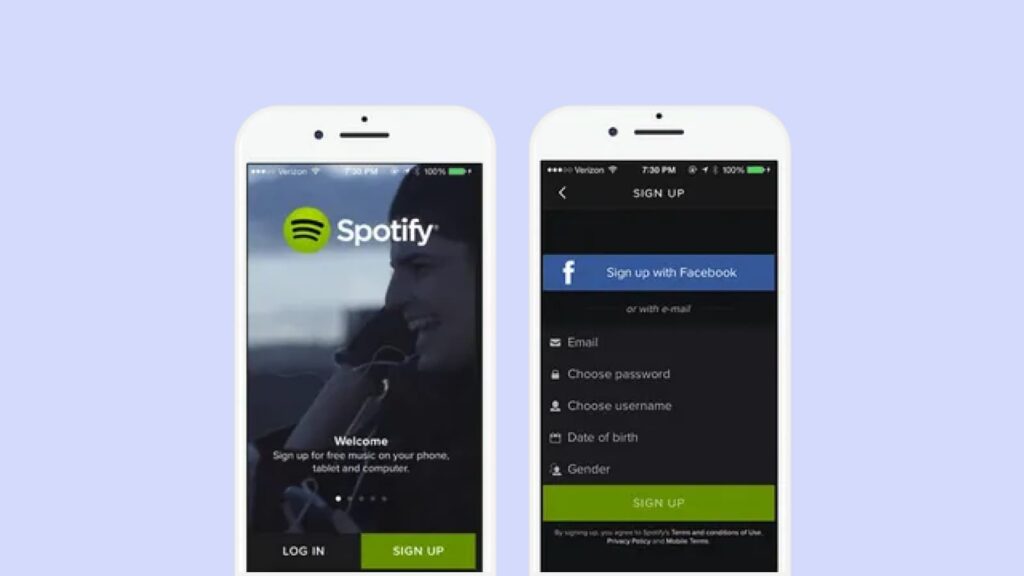Today, the mobile application market has long formed its own “hierarchical system,” in which monopoly giants and applications have occupied their unique niche. Breaking into this market is not easy, but it is possible. This will require an accurate understanding of the audience, the specifics of competitors, and, of course, an idea. Today, we’ll discuss where to start the development process and how to succeed in it!
How to Start Spotify App Development
With the evolution of web and mobile technologies, music is now accessible during various modes of transportation or while waiting in public spaces. While music streaming apps boast user-friendly interfaces, replicating the Spotify app for business purposes demands additional expertise and resources.
Success in today’s mobile app market hinges on creating high-quality and innovative products. Spotify excels in both these aspects. Before delving into the music streaming services development, dissecting the features of the industry’s leading app is crucial. Failing to keep pace with the giants in the field could lead to a 100% chance of falling behind.
Spotify is renowned for its high-speed music streaming and audio quality. It utilizes a peer-to-peer network that transforms users into microservers, facilitating faster data exchange. For instance, when a user plays a song, their device becomes a data carrier, expediting the download of that music from nearby users, thereby relieving the burden on central servers.
It’s important to note that one user doesn’t have to be the sole provider of a track. Spotify can gather individual segments of songs or entire playlists from various devices belonging to different users.
The app is designed to access a device only when proper monitoring measures are in place and doesn’t communicate with external servers. It retrieves data from the cache folder, enabling the playback of selected songs even without an internet connection. The developers of the Spotify app have provided recommendations for distinguishing oneself in a competitive market. Now, let’s delve deeper into the development process, its stages, and the sequence of steps involved.
Developing the App
Project completion includes preparation, development, and finishing stages, regardless of the product type. We will examine the Spotify development process as a case study.
During the preparatory phase, various tasks are carried out, such as outlining application options, creating user storyboards, developing test plans, and providing the client with a comprehensive estimate.
During development, tasks such as designing, implementing app options, and conducting testing are carried out. The final step involves presenting the completed project to the client and addressing any minor issues that may arise. At this moment, let’s talk about actions. Now, let’s talk about how to create a streaming service in more detail:
Analyze and research. Before beginning development, conducting a thorough analysis of competitor products is recommended, as compiling a list of essential features for the app and deciding on necessary functionalities to include.
Design interface. Create a mockup or prototype of your application to help you visualize how it works and looks. During this stage, you should also consider user navigation, visual elements, and animations.
Develop backend infrastructure. A dependable backend is crucial for streaming service like Spotify. Your project’s specific requirements will determine the technology and database selection for developing the backend system for your Spotify-like application.
Integrate Audio Streaming Technology. Audio streaming technology is crucial in music streaming applications, allowing seamless audio playback while users browse their music collection, as demonstrated by Spotify.
Build User Profiles. Include features like user profiles with different levels of access based on subscription plans or free trials; allow users to view their playlists; let them add new tracks to existing playlists or create new ones; provide them with an option to follow other users etcetera.
Test & Deployment. Once all the necessary features have been implemented into the app, it’s time for the testing phase! Run extensive tests before launching the final version so that everything works just as expected when users start using it.

Knowing about all the technical aspects of the work, it’s time to move on to a topic no less important and exciting. Namely, the cost of everything described above. We do not give specific examples of prices, but we will explain why everything costs that way.
Cost of music-streaming app development
The cost of developing an application is influenced by factors such as the technology stack used and the features implemented. Moreover, the choice of development approach matters; if you opt for an in-house development team, the costs may be significantly higher than outsourcing the project to a third-party company.
We need a comprehensive understanding of your app concept to provide an accurate project estimate. On average, Spotify app development may cost you anywhere from $30,000 to $300,000+.
Before starting development, we recommend you immediately try to find app developers. The sooner you find a partner, the easier development will be and the less chance that possible errors will pass with the application before release. The main thing to remember is that you should look not only at the price offered by the artist but also at their portfolio and reviews. Trust exclusively experienced teams of specialists.
